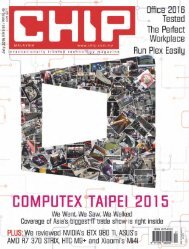Create successful ePaper yourself
Turn your PDF publications into a flip-book with our unique Google optimized e-Paper software.
technotes » computex <strong>2015</strong><br />
Making motherboards<br />
Ever wondered what<br />
goes into assembling<br />
a PC motherboard?<br />
Shaun Prescott reports<br />
after receiving a firsthand<br />
look in Taipei<br />
earlier this year.<br />
Down on the fifth floor dozens<br />
of production line workers<br />
apply the more fiddly<br />
components of a motherboard.<br />
16 www.apcmag.com<br />
As part of a guided tour to<br />
coincide with Computex in<br />
June, Gigabyte took me to<br />
its Taipei motherboard<br />
factory on the outskirts of the<br />
city. Situated in a small industrial<br />
town about an hour out of central<br />
Taipei, Nanping is the biggest of the<br />
company’s three motherboard plants,<br />
with the other two – Dongguan and<br />
Ningbo – based in China. Opened in<br />
2000, Nan Ping employs 1,500 people<br />
and produces 575,000 motherboards<br />
per month. Each of these are tested<br />
before shipping, and each are created<br />
with a mixture of automation and<br />
manual labour.<br />
The only aspect of motherboard<br />
creation not accounted for at Nanping<br />
is the printed circuit board (PCB),<br />
which is made in China. Otherwise,<br />
each motherboard is crafted ‘from 0<br />
to 100%’ at the plant. On the seventh<br />
floor, large (and loud) surface-mount<br />
technology (SMT) machines slot tiny<br />
resistors and other chips onto the<br />
PCBs, with several workers responsible<br />
for testing the results at the end of<br />
the line. These SMT machines are<br />
capable of slotting in components<br />
at a speed of half a second, with long<br />
reams of tiny components fed into<br />
the SMT automatically.<br />
While the seventh floor is mostly<br />
automated, the manual assembly line<br />
two floors down is where the more<br />
delicate work happens. That said, it<br />
doesn’t look delicate — dozens of<br />
Taiwanese women sit elbow to elbow<br />
placing components at blinding speeds<br />
— but a lot of care and attention is<br />
afforded to the process and again,<br />
every motherboard is also functiontested<br />
before leaving the premises.<br />
Each worker wears an antistatic<br />
wristband, and each has trays full of<br />
ports, chips and transistors, which<br />
they apply as a conveyor transports<br />
an endless stream of PCBs throughout<br />
the floor. On the day I visited, the<br />
target was 1,500 motherboards. That’s<br />
a lot of USB ports manually slotted in.<br />
Down on the second floor is where<br />
packing happens. This is a thorough<br />
process and, despite being the least<br />
technical part, easily the most<br />
fascinating: machines beat cardboard<br />
boxes into shape while men and women<br />
carefully place the motherboard,<br />
cables, driver disc and all manuals<br />
into the package you purchase at<br />
retail. While the process of building<br />
the actual motherboard may seem<br />
remote and foreign to anyone with<br />
sub-professional technical knowledge,<br />
watching the actual product<br />
materialise before your eyes is… well,<br />
eye-opening. The next time you throw<br />
your motherboard’s manual away,<br />
keep in mind the guy tasked with<br />
putting 1,500 of these into 1,500<br />
boxes, every day. Each motherboard<br />
package is then stacked into a bigger<br />
box and sent directly from Nanping<br />
to Gigabyte’s wholesalers.<br />
That’s a lot of motherboards built per<br />
day, and for what is arguably the least<br />
sexy component of a PC, quite a lot of<br />
work. For me, the tour was a welcome<br />
reminder that PC components don’t<br />
just materialise from out of nowhere in<br />
boardrooms or retail outlets: they’re<br />
painstakingly constructed by dozens<br />
of human hands.<br />
Shaun Prescott attended this year’s<br />
Computex courtesy of Gigabyte.<br />
A PCB passes through the automated<br />
lines on the seventh floor, where larger<br />
components are applied by machine.<br />
Each worker wears an<br />
antistatic wrist band to ensure<br />
none of the delicate pieces are<br />
zapped by rogue electricity.<br />
On the second floor, packing<br />
is also done manually.<br />
Everything you get in the box<br />
is placed there by a human.
















